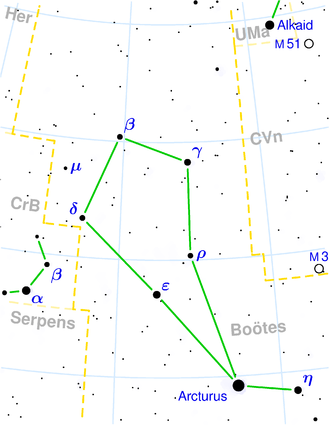NGC 5490
| Galaxy NGC 5490 |
|
|---|---|

|
|
| SDSS recording | |
| AladinLite | |
| Constellation | Bear keeper |
|
Position equinox : J2000.0 , epoch : J2000.0 |
|
| Right ascension | 14 h 09 m 57.3 s |
| declination | + 17 ° 32 ′ 44 ″ |
| Appearance | |
| Morphological type | E. |
| Brightness (visual) | 12.0 mag |
| Brightness (B-band) | 13.0 likes |
| Angular expansion | 2.4 ′ × 1.9 ′ |
| Position angle | 5 ° |
| Surface brightness | 13.7 mag / arcmin² |
| Physical data | |
| Affiliation | LGG 376 |
| Redshift | 0.016195 +/- 0.000080 |
| Radial velocity | (4855 +/- 24) km / s |
|
Stroke distance v rad / H 0 |
(218 ± 15) x 10 6 ly (66.8 ± 4.7) Mpc |
| history | |
| discovery | Wilhelm Herschel |
| Discovery date | March 14, 1784 |
| Catalog names | |
| NGC 5490, 5490A • UGC 9058 • PGC 50558 • CGCG 103-095 • MCG + 03-36-065 • GC 3798 • H III 32 • h 1752 • LDCE 1039 NED001 | |
NGC 5490 , also called NGC 5490A , is a 12.0 mag bright elliptical radio galaxy of the Hubble type E? in the constellation Bear Keeper and 218 million light years from the Milky Way.
Together with the non-NGC objects PGC 50572 (also called NGC 5490B ) and Arp 79 ( PGC 50584 , also called NGC 5490C ), it forms an optical triple galaxy and was created by Wilhelm Herschel on March 14, 1784 with an 18.7-inch -Mirror telescope discovered, which described it as “vS or nebulous double star, verified 240 power”.
NGC 5490 group ( LGG 376 )
| Galaxy | Alternative name | Distance / million Lj |
|---|---|---|
| NGC 5490 | PGC 50558 | 218 |
| IC 982 | PGC 50560 | 245 |
| IC 984 | PGC 50580 | 229 |
| PGC 50657 | UGC 9078 | 213 |
